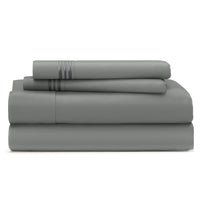
10 Incredible Facts About The Bamboo Plant & Bamboo Viscose
No one loves bamboo viscose as much as we do at Cosy House. Bamboo viscose is a blended material made with the cellulose of the bamboo plant and mixed with other materials such as microfiber polyester for maximum softness and comfort. What makes bamboo such a special plant? In honor of World Bamboo Day on September 18th, we’re going to break down the 10 most incredible facts about the bamboo plant and bamboo viscose fabrics!
The Bamboo Plant is Stronger Than Steel
Bamboo has been used for building homes and other structures for years. But is it really stronger than steel? In terms of tensile strength, yes! Tensile strength is defined as “the resistance of an object to breaking under tension.” Steel measures out at 23,000 lbs. per square inch. Bamboo, on the other hand, has a 28,000 tensile strength.* How can bamboo be so strong? Well, it has a tighter packed molecule structure making it harder to split under tension.
Bamboo Viscose is Naturally Hypoallergenic
One of the best features of our Cosy House bamboo viscose blended material is it’s hypoallergenic properties. Unlike other textiles, the fibers of bamboo viscose are incredibly breathable and lightweight, able to ward off common household non-living allergens. In fact, bamboo viscose is the perfect solution for anyone who has sensitive noses or skin. Our bamboo viscose blended bedding is unmatched!

The Bamboo Plant is a Renewable Resource
Bamboo is one of the fastest-growing renewable sources on the planet and uses less water than cotton. In fact, certain species of bamboo can grow up to 3ft per day! This means that farmers can cut down stalks of bamboo and have it renew virtually overnight. The Giant Bamboo even holds the world record for the tallest bamboo plant at 164ft. That’s a lot of bamboo!
The Bamboo Plant Gives Off Incredible Amounts of Oxygen
We’re sure you’ve heard at some point or another that trees produce oxygen. Well, this occurs because they draw in carbon dioxide and convert it into oxygen through photosynthesis. This process helps trees grow taller and stronger. Since bamboo grows so quickly, it draws in more carbon dioxide and puts out more oxygen than the average plant. This is why bamboo forests have been recommended as a solution to climate change.
The Bamboo Plant Prevents Ground Erosion
Bamboo is what we like to call a “community plant.” When planted, bamboo grows very close together, creating dense patches of growth. In addition, it develops an incredibly intricate root system. This means that it is able to create a barrier in areas that are prone to erosion.

The Bamboo Plant is Often Used in Asian Cuisine
We’re guessing you’ve only thought of bamboo as panda food. Surprise! Humans can eat it too! In fact, bamboo has been an ingredient of many Asian dishes for centuries. Now, don’t try chomping into a stalk of bamboo. It’s actually the bamboo shoot that is consumed. Bamboo shoots are the sprouts of the bamboo and are used as vegetables in many dishes.
The Bamboo Plant is a Grass, Not Wood
You may have heard bamboo referred to as “bamboo trees,” but that is a misnomer. Bamboo is not technically classified as a wood or a tree. “But how can that be?” you might be asking yourself. After all, bamboo is pretty hard, like wood. Surprisingly, what makes bamboo a grass is its hallmark feature: hollow, cylindrical tubes. Trees are the complete opposite, with thick trunks.
The Bamboo Plant Grows All Over the World
Though it is most associated with China, bamboo is an incredibly versatile plant. With over 1400 species, bamboo grows on five of the seven continents. There are even species indigenous to Australia, Chile, and Mexico. They possess the unique ability to survive negative twenty degrees Fahrenheit and flourish when spring rolls back around.

The Bamboo Plant Saves Endangered Pandas
If there’s one thing that bamboo is known for it’s being the main food for panda bears. Deforestation in China has been devastating to its population of pandas. However, with renewed efforts to save this endangered species, forests full of bamboo have been grown. Though there is still a long way to go to save the panda species, this planting has removed their “endangered” status.
Bamboo Viscose Makes for Some Seriously Soft Pillows
If we’ve said it once, we’ll say it again: bamboo viscose material makes for incredible pillows! Known for its softer-than-silk texture, bamboo viscose pillows are naturally cooling, wicking away moisture and heat from the body, leaving you cool and comfortable. Check out our Luxury Pillows here!
We've gone ahead & enclosed a 10% off coupon below for you to use if you'd like to take the plunge and try out our sheets for yourself! To shop our collection & get 10% OFF Use the code 'BLOG10' at checkout.
Resources:
“Dracaena Sanderiana.” Wikipedia, 29 June 2021, en.wikipedia.org/wiki/Dracaena_sanderiana.
“Can Structural Bamboo Replace Steel in Construction Soon? | SBC Magazine.” Www.sbcmag.info, www.sbcmag.info/news/2020/jan/can-structural-bamboo-replace-steel-construction-soon#:~:text=How%20bamboo%20surpasses%20steel%3F.
“Bamboo Textile.” Wikipedia, 6 Jan. 2021, en.wikipedia.org/wiki/Bamboo_textile.
Ocko, I. (2015, January 27). As bamboo forests fade, can pandas survive? (op-ed). LiveScience. Retrieved from https://www.livescience.com/49596-as-bamboo-forests-fade-can-pandas-survive.html.
Awesome 10 bamboo plant facts - bamboo fun facts for kids. SmartClass4Kids. (2020, December 23). Retrieved from https://smartclass4kids.com/science/plants-facts/bamboo-plants-facts/.

